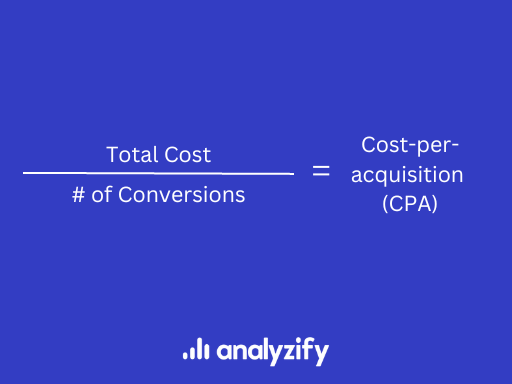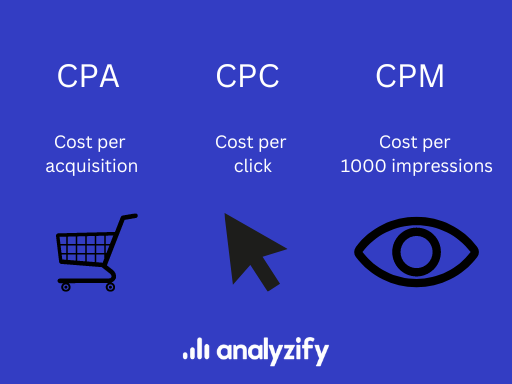The cost per action (CPA) is one of the most important metrics of paid advertising campaigns. Although the CPC and CPM are also quite popular in digital marketing, CPA takes the lead due to its ability to minimize your overall costs and achieve the desired ROI. In the cost-per-acquisition or cost-per-action model for online advertising, the advertiser only pays for specific acquisitions such as a sale, signup, form submission, or a lead. In this article, we’ll go through the basics of cost-per-action in digital marketing. This is a highly crucial variable of marketing that you need to understand before you can optimize it.
What is Cost Per Acquisition (CPA)?
Cost-per-acquisition (also used as cost-per-action), can be described as the cost a business pays to obtain a desired action from a potential customer. This action could be anything from acquiring the customer to having them submit a form, or any other action the business defines as a conversion.
CPA is used as a metric to decide on the best possible digital marketing strategy, along with other widely known payment methods, which are cost-per-mille (CPM) and cost-per-click (CPC).
What is CPA in Digital Marketing?
Digital marketing relies on links to attract potential customers, but the process of getting them to click on a banner, follow the link, and make a purchase can be challenging. The competition is fierce, whereas the attention of customers and the money that can be spent on advertising are very limited.
When this is the case, deciding on the best approach to make the most sales while spending the least amount of money is highly crucial, and this is where CPA comes into play.
As mentioned above, CPA in digital marketing can both be addressed as a metric and a payment method for a business that wishes to advertise online. Compared to other methods, the advertising cost is based on the number of acquisitions made through the ad that was shown. So, the idea is for the customer to not just see or have a brief exchange with the ad but go through the whole transaction.
Although the cases may differ, CPA in marketing is usually composed of 3 main elements:
- An affiliate (aka. a publisher)
- An advertiser (the business)
- A CPA network (the platform
The advertiser has a product (or a service) to sell, and they reach out to their affiliate of choice through the CPA network. Here, the affiliate displays the advertiser’s product to their own audience (whether through a social media post, video content, blog post, etc.) and gains a commission each time someone from their audience decides to buy the product through the displayed link.
This whole scenario results in revenue for both parties and is highly applicable in today’s market, considering the high rise of influencers and time spent online all over the world. As such, payment models like CPA play an important role in digital marketing since they largely influence the ad strategy for many businesses.
How is CPA Calculated in Digital Marketing?
Calculating CPA in marketing is actually pretty straightforward: simply divide the total cost of ads by the total number of conversions, and you’ll get how much you spend on an ad for each conversion you make.
For example, if you spent $60 on an ad campaign and it got you 10 conversions, then you can think of your cost-per-action rate as $6. This means that for each customer you get, you spend $6 for the ad.

What’s A Good Cost Per Acquisition (CPA)?
As you may have guessed, there isn’t really a definitive standard when defining a good CPA in marketing. The optimal rates differ across industries, and the budget of the advertiser as well as the desired return on investment (ROI) play a very important role when deciding if a CPA indicates good signs. Having said that, a good CPA should be both high enough so that it remains competitive and low enough so that it is profitable.
The recent data shows that the average CPA across industries in Google Adwords is $59.18 for the search network and $60.76 for the display network. For the search network, the leading industry is “Legal” with a rate of $135.17, while the last place goes to “Dating & Personals” with $6.91. As for the display network, the spots are changed with “Employment Services” at $129.69 and “Technology” at $19.23.
In short, you need to keep in mind that a “good” CPA in marketing never remains at a fixed rate. As marketing trends change and businesses evolve over time, it will be beneficial to always update your goals for CPA.
Why is CPA Important in Marketing?
Effective marketing strategies are essential for driving sales and maximizing revenue. By optimizing your marketing efforts through techniques such as cost-per-action (CPA), you can increase the number of conversions and reduce advertising costs, leading to a more profitable business. Understanding the importance of CPA in marketing can help you optimize your campaigns and achieve better results.
Once you optimize your campaigns, you’ll have a higher chance of acquiring customers for the lowest possible cost. However, not all businesses are the same -nor at the same phase in the whole growth-share matrix. Therefore, it is important to know about other types of payment methods in digital marketing, so that you can decide on the best approach for your business and advertising strategy.
What are the Differences between CPM, CPC, and CPA?
Besides cost-per-acquisition, two other methods are widely used in digital marketing, which are called cost-per-mille (CPM) and cost-per-click (CPC). As you can guess, all 3 have different advantages and disadvantages, and choosing the correct one for your own ad strategy is highly important. So, what are the differences between them?

What is Cost-per-mille (CPM)?
CPM is the cost of the ad for 1000 impressions (as “mille” means thousand in Latin). For example, if you spent a total of $6000 on an ad and got 6000 views, your cost-per-mille would be $1000 (since each view would cost $1 and 1000 views would cost $1000). Because CPM is based solely on the number of impressions (rather than clicks, acquisitions, or any other actions), it is largely used for creating brand awareness.
What is Cost-per-click (CPC)?
As can be derived from its name, the cost-per-click model refers to the cost of the ad each time it gets a click. If we again consider your ad spent as $6000, and this time you get 6000 clicks, then the cost of each click would be $1. Again, what matters here is the click and not the view or impression itself, so the method is largely used for navigating traffic to a website.
How are they Different from Each Other?
At first, you may think that CPA outrivals CPM or CPC because what matters is the sale itself, right? But this is really not the case -at least not all the time. Depending on the scenario, using any of the 3 could turn out to be highly inefficient, such as when:
As you can see, each model offers a different level of control and risk for the publisher and the business. CPM poses the lowest level of risk for the publisher because simply displaying the ad will be sufficient. Whereas for the advertiser, the lowest level of risk is through CPA, as conversion will be ensured.
So, we can’t really say there is a one-size-fits-all approach where one technique completely triumphs over the other. Each business should consider its own strategy when deciding to choose between these 3 concepts, which should always prioritize the desired return on investment (ROI) in addition to the website and ad banner’s conversion strength.
In short…
CPA is one of the most popular payment methods and metrics in digital marketing to optimize ad strategies. Understanding the importance and the difference between other methods allows you to optimize costs so that you can focus on gaining the highest return on investment. Different models can be good for different businesses, and you should always consider your business’s own strengths and weaknesses before deciding and keep your budget and desired ROI at the forefront of your mind.

































